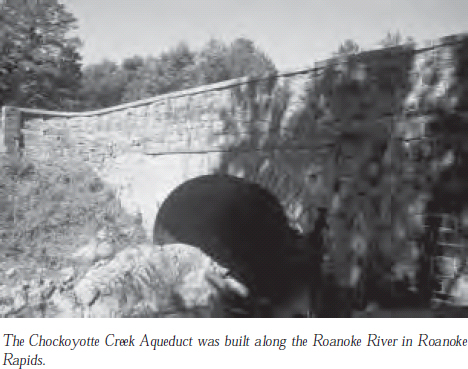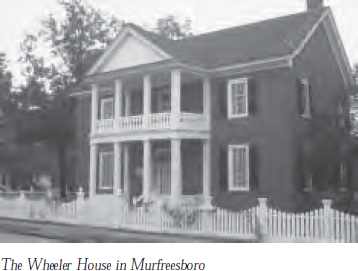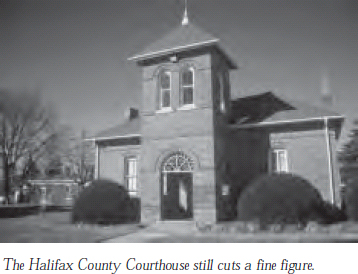
Warrenton, Halifax, Roanoke Rapids, Weldon, Murfreesboro
This weekend getaway is admittedly off the beaten track. Roanoke River country may at first glance seem to offer little to the weekender. But that’s only what the first glance reveals. A second look shows that the part of eastern North Carolina that shares a border with Virginia provides a perfect, albeit low-key, weekend getaway that combines excellent antiquing opportunities, interesting historical sites particularly for Civil War and civil engineering buffs, and a little bit of hiking.
Geographically dispersed, Roanoke River Country includes the town of Roanoke Rapids, the little gem of Warrenton to the west, and Weldon, Halifax, and Murfreesboro to the east. Together, these towns form a cluster of heritage-laden communities where you can glimpse what life was like for North Carolinians from before the Revolution right up to the Civil War. The best aspect of a visit here is that you don’t have to wade through the touristy trappings common to more popular spots. And be sure to take comfortable walking shoes. You’ll be so impressed by the many drop-dead gorgeous antebellum homes in Warrenton that you’ll want to stroll about the neighborhoods.
If you plan a weekend of antiquing, stay in Warrenton at The Ivy Bed and Breakfast (800-919-9886 or 252-257-9300; www.bbonline.com/nc/theivy). It’s on Main Street within walking distance of everything. If you’d rather stay in Roanoke Rapids, consider Twin Magnolias Bed and Breakfast (252-308-0019; www.angelfire.com/biz/twinmagnolias/), a reclaimed mill house in the historic district. If Weldon is more convenient for your plans, lodge at the Weldon Place Inn (800-831-4470 or www.allaboutbootleg.com/WPI/), a beautiful Colonial Revival home built in 1914 for Herbert Harrell, a successful local printer.
Where to Eat
In downtown Warrenton, eat at the Hardware Café, which began life as the W. A. Miles Hardware Store in 1907. In nearby Littleton, you can enjoy a steak or seafood dinner at Mordecai’s Restaurant and Wisteria Pub. In Roanoke Rapids, you might try Carini’s Italian Restaurant, or David’s Restaurant, which specializes in steaks, seafood, and veal. In Weldon, the diner called Frazier’s Restaurant keeps everyone happy with its home-style cooking.
Ways to While Away the Day
Antiques
At last count, 9 shops crowded Main Street in Warrenton. If you don’t mind a five-mile ride on U.S. 158 West to Norlina, you can visit Roost Crossroads Antique and Collectibles Shop. Halifax sports a pocketful of shops, Estelle’s Antiques being the most well known. Weldon is home to General Store Antiques, located downtown on Washington Street.
Architecture
If you’re coming from the east, take time for a walking tour of Murfreesboro, once a thriving port town on the Meherrin River. On a walk here, you’ll see private homes, old schools, and commercial buildings that predate the Civil War. Of particular interest are the Wheeler House and the McDowell Columns Building on the campus of Chowan College.
Warrenton is an architecture lover’s dream. Many of its stately homes were built by Jacob Holt, the chief architect during Warrenton’s boom era (1845-1861), when Warren County was the richest in the state. He worked primarily in the Greek Revival and Italianate styles. The local visitor center is located in Holt’s former home. Look, too, for the childhood home of the Bragg boys—Thomas, who served as governor of North Carolina from 1855 to 1859; Braxton, who served as a general under Robert E. Lee; and John, who served as a congressman and a state supreme-court justice in Alabama. Thomas won the first election in North Carolina in which 100,000 people voted. Braxton gave his name to Fort Bragg. As you walk through town, be sure to admire the wonderful storefronts, many of which sport French front doors and glass display windows jutting out to the sidewalk.

Civil War History
Weldon was a focal point of Civil War action in 1863. The Wilmington-Weldon Railroad, a supply line from the port of Wilmington to Confederate forces in Virginia, crossed a crucial bridge on the Roanoke River. If the bridge could be burned, then the supply line could be stopped. Obviously, Confederate forces weren’t going to let that happen. Though the original span has been lost to the ages, the bridge where U.S. 158 and U.S. 301 cross the river is about where it stood. To read about the skirmishes that resulted when Union troops tried to take the railroad, consult Clint Johnson’s Touring the Carolinas’ Civil War Sites.
The former grave of Annie Carter Lee, Robert E. Lee’s daughter, is south of Warrenton on U.S. 401. The young woman contracted typhoid fever while vacationing in Warren County and died there. She was later moved to the family crypt in Lexington, Virginia.
Heritage
Though Halifax looks quiet today, it once was a busy port hopping with warehouses, inns, and taverns. It was also a political center. North Carolina’s Fourth Provincial Congress met here in April 1776. Today, you can wander what remains of Halifax’s glory days. The visitor center at Historic Halifax State Historic Site offers a video recapping local history; it also houses exhibits showing colonial life. Several other structures are open to the public. The complex is open state hours. For more information, call 252-583-7191 or visit www.ah.dcr.state.nc.us/sections/hs/halifax/halifax.htm.
Museums
The Brady C. Jefcoat Museum in Murfreesboro is loaded with goodies! Occupying an old high school built sometime around 1922, the museum purports to have the country’s largest collection of old butter churns, irons, and washing machines. My favorite collection is that of Victrola phonographs and their artfully designed horns. The museum is open Saturday from 11 A.M. to 4 P.M. and Sunday from 2 P.M. to 5 P.M. For more information, call 252-398-5922 or visit www.murfreesboronc.com/historic/tour/jefcoat.htm.

Hiking
If simple in-town walking isn’t enough for you, go for a hike. The most interesting local trail is the Roanoke Valley Canal Trail in Roanoke Rapids. Early settlers saw that the Roanoke River, which rises near Blacksburg, Virginia, and travels nearly 400 miles to the ocean, could open trade from the western reaches of Virginia to Albemarle Sound if only the Great Falls, in what is now Roanoke Rapids, could be navigated. Therefore, in 1812, the Roanoke Navigation Company started building a nine-mile canal to carry traffic around the Great Falls. Today, as you walk the canal trail, you’ll see remnants of the glory days. Enough structures are left to let you glimpse what river commerce was like over 150 years ago. The best access point is Edwin Akers Park, located on Ponderosa Road off U.S. 158 outside Weldon. Here, you can see the most impressive structure along the trail, the Chockoyotte Creek Aqueduct. The other access point is just off River Road in Roanoke Rapids. Call 252-533-2847 for a brochure that contains a map of the canal trail.
Tidbits
Historical displays in Halifax describe a beverage made of strong beer, molasses, and rum and stirred with a hot poker. The colonists called this witch’s brew “Flip.” One can only imagine why.
Lots of famous people have ties to Murfreesboro and the surrounding area, including Richard Jordan Gatling, who invented the Gatling gun; Walter Reed, who dedicated himself to eradicating yellow fever; and Emily Morgan, a mulatto slave girl who inspired the song “Yellow Rose of Texas” and who helped Sam Houston win the Battle of San Jacinto. Her legend is that she held Mexican general Antonio Lopez de Santa Anna in an amorous embrace while the Texans attacked his tent.
Saying that Warrenton is steeped in history is like saying that summer can be hot in North Carolina. For starters, Warrenton is named for Joseph Warren, a solider killed at Bunker Hill. It’s not often you’ll find a Southern town named for someone who died in a battle in New England. Then there’s the plethora of historical markers in and near town. One notes that Horace Greeley, who evidently went south for a bride while telling other young men to go west, was married in Emmanuel Episcopal Church in downtown Warrenton in 1836. Mary Turner, granddaughter of Francis Scott Key, author of the “Star-Spangled Banner,” is buried at that same church. Yet another marker commemorates John Adams Hyman, North Carolina’s first black congressman. By age 26, Hyman had served on two committees at the Freedmen’s Convention of North Carolina and was a delegate to the March 1867 Republican State Convention.
Though mountains are hard to come by in this part of the state, they’re not impossible to find. Medoc Mountain State Park, located near Hollister, actually has a summit! In addition to scaling a rather impressive granite ridge, you can walk along land that was once cultivated for grapes as you pass by creeks, remnants of old dams, and lots of large quartz rocks typical of the land near the fall line that separates the coastal plain from the Piedmont. By combining the Summit Loop with the Dam Site Loop, located on the eastern side of the park, you can concoct a four-mile, mostly shady hike that gains about 325 feet in elevation on the remains of a mountain range formed 350 million years ago by volcanic action. For more information, call 252-586-6588 or visit www.ils.unc.edu/parkproject/visit/memo/home.html.
Festivals/Events
| May | Murfreesboro Historic District Tour |
| Late July | Murfreesboro Watermelon Festival |
More Resources
For information, contact the Halifax Tourism Development Association by calling 800-522-4282 or 252-535-1687 or by visiting www.visithalifax.com.
The Warrenton Visitor Center is open Saturday from 10 A.M. to 5 P.M. and Sunday from 1 P.M. to 5 P.M. If you visit mid-week, call 252-257-3114 to get a copy of Warrenton’s walking-tour brochure. You can also scope out the area by visiting www.warrenton-nc.com.